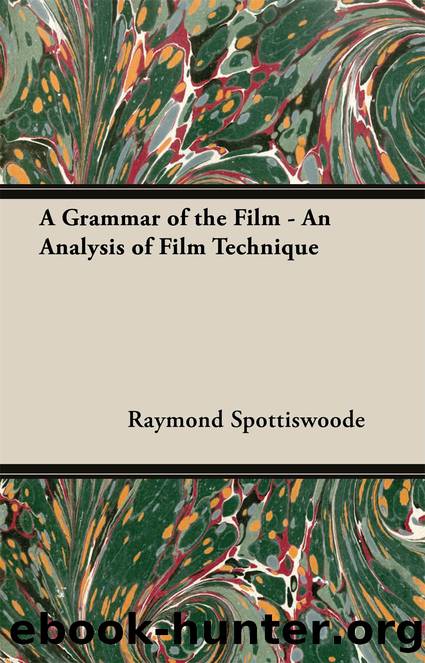A Grammar of the Film - an Analysis of Film Technique by Raymond Spottiswoode

Author:Raymond Spottiswoode [Spottiswoode, Raymond]
Language: eng
Format: epub
Tags: Performing Arts, General
ISBN: 9781473389472
Google: uSl-CgAAQBAJ
Publisher: Read Books Ltd
Published: 2013-05-31T23:53:21.884747+00:00
25. Lastly, we turn to superimposition, the limiting case of which is reduplication. In the silent cinema the difficulty of conveying thoughts in the absence of speech was sometimes overcome by fading in, on top of some part of the existing shot, a sort of medallion of a young woman pining for release from her captors, or a young man riding gallantly to a rescue. This device was universally disapproved by the intelligent critics, but its recent reappearance in The Constant Nymph shows that it is not yet dead; it merits examination, but as it raises the large issues of the pictorial propagation of thought, this treatment must be deferred to the next chapter. A few structural comments are in place here. The object, if any, which has given rise to the reflection must not intrude itself on the inserted shot. In one instance in The Constant Nymph, a letter was to be seen apparently racing across the surface of a hockey field; in Pacific 231 the clash of âcellos and railway engines, though intentional, was little better than absurd.
A quite distinct application of superimposition proposes to take advantage of this mêlée. Emotional or physical disturbances are often represented by a multiplicity of simultaneous shots, containing movements in constant conflict with one another, while the shots themselves loom out of the distance and, before they are clearly seen, disappear into it again. (Cf. the war sequence in Cavalcade, Lloyd, 1933.) This device is based on a fallacy. Just as it is not permissible for the novelist to convey boredom by boring his readers, so the director must not convey confusion by confusing his audience. The artist should aim at keeping continually alert the minds and emotions of those who are to appreciate his work. If he stuns them with the impact of his presentation, they will become numb and unresponsive; if he bewilders them, they will try to find some distinct statement where none was intended, and in the resulting incoherence of mind they will fail to attend to a succeeding passage in the work which would otherwise have presented no difficulties to them. Superimposition for this purpose ought to be abandoned altogether.
There is still another use for it, however. Pudovkin, in Deserter, superimposed on the detail work of riveting and hammering the ship an outline shot in fast motion of the whole ship coming to completion. The idea was highly ingenious, though it could not often be used without gaining an appearance of virtuosity. A small part of the work was used to typify an entire and complex process; but as it was impossible to convey thereby a conception of the whole, that was shown simultaneously; brevity and clearness were thus combined.
A variation on this use has lately been seen in Stuart Leggâs Telephone Workers. To gather together at the end the various threads of the film, and impress the dependence of the individual householder with his telephone on the complex system which had been described, Legg superimposed various representative parts of the system on a shot of a row of houses.
Download
This site does not store any files on its server. We only index and link to content provided by other sites. Please contact the content providers to delete copyright contents if any and email us, we'll remove relevant links or contents immediately.
Kathy Andrews Collection by Kathy Andrews(11678)
The remains of the day by Kazuo Ishiguro(8746)
Paper Towns by Green John(5024)
Spare by Prince Harry The Duke of Sussex(4996)
The Body: A Guide for Occupants by Bill Bryson(4887)
Industrial Automation from Scratch: A hands-on guide to using sensors, actuators, PLCs, HMIs, and SCADA to automate industrial processes by Olushola Akande(4846)
Machine Learning at Scale with H2O by Gregory Keys | David Whiting(3970)
Be in a Treehouse by Pete Nelson(3876)
Harry Potter and the Goblet Of Fire by J.K. Rowling(3737)
Never by Ken Follett(3703)
Goodbye Paradise(3666)
Into Thin Air by Jon Krakauer(3261)
The Remains of the Day by Kazuo Ishiguro(3254)
The Cellar by Natasha Preston(3219)
The Genius of Japanese Carpentry by Azby Brown(3189)
Fairy Tale by Stephen King(3156)
120 Days of Sodom by Marquis de Sade(3118)
Drawing Shortcuts: Developing Quick Drawing Skills Using Today's Technology by Leggitt Jim(2960)
The Man Who Died Twice by Richard Osman(2955)
